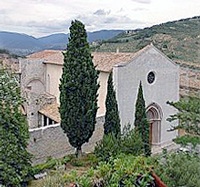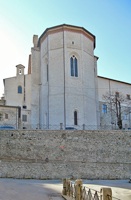


This seems to have been the site of a temple from the time of the foundation of the Roman colony (see below) and subsequently of the churches of San Nicolò da Bari and San Massimo.
In 1263, Bishop Bartolomeo Accorambi gave this (by then ancient) church of San Nicolò da Bari to a community of Augustinian hermits, who moved here from what is now San Salvatore. They subsequently acquired the church of San Massimo from the canons of San Gregorio Maggiore and they also acquired a number of nearby houses. All of these properties were demolished to make way for a new church and convent. The foundation stone of the present church, which is formally dedicated as SS Agostino, Nicolò e Massimo, was laid in 1304.
-
✴The subterranean church of Santa Maria della Misericordia was built under the apse of the new church.
-
✴The nearby church of San Biagio (later Sant’ Alò) also belonged to San Nicolò.
The relics of the Blessed Christina Semenzi, a nun who worked at the the Ospedale di San Matteo and who died there 1458, were originally preserved under the Altare di San Michele at San Nicolò. A cult developed when miracles were reported at her tomb.
The friars' convent became the most important centre of learning in Spoleto and had an extensive library. Martin Luther is reputed to have stayed here in 1512.
The convent declined considerably in the 17th century and was damaged when it was used as a barracks by Spanish soldiers in 1745. Further damage occurred in the earthquake of 1767. The complex was suppressed in 1798. (The friars moved to the Collegio della Madonna di Loreto in 1803 and managed to stay there until 1860).
The relics of the Blessed Christina Semenzi were moved to the Madonna di Loreto in 1803 and to San Gregorio Maggiore (their present location) in 1921.
The complex had a variety of secular uses until its restoration in 1967. It now hosts major conferences on a regular basis.
Exterior


The fine polygonal apse of the church penetrates the remains of the city walls in Via Cecili.



The campanile (15th century) was demolished in 1873.

Art from the Church
The following sculptures from San Nicolò are now in Room 9 of Room 9 of the Museo del Ducato di Spoleto.
-
✴a decorated marble lunette (12th or 13th century);

-
✴a pair of sculpted lions (12th century); and

-
✴a relief (12th or 13th century).

-
This relief , which depicts scenes from the martyrdom of St Blaise, was removed from the external left wall of San Nicolò in the 19th century. It probably came originally from San Biagio (later Sant’ Alò), which belonged to San Nicolò.
Archeological Finds from the Site
Antefixes from a Temple (3rd and 2nd centuries BC)
These antefixes from a temple on the site, which are now in the Museo Archeologico, include:
-
✴decorative elements from a frieze;

-
✴a fragment from an antefix representing “Potnia Theron” (Artemis as Mistress of the Animals), in which the goddess is flanked by rampant panthers; and

-
✴a fragment of a young man.


